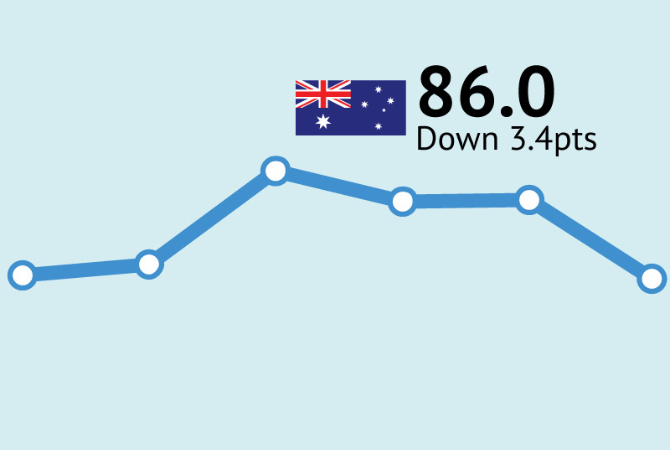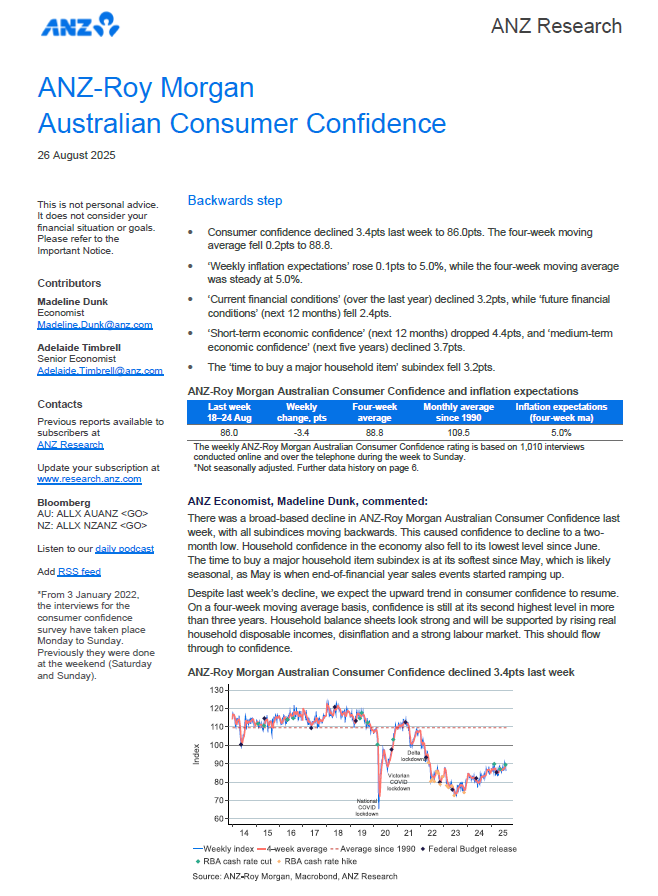ANZ-Roy Morgan Consumer Confidence drops 3.4pts to 86.0 in late August – its lowest for two months since mid-June

ANZ-Roy Morgan Consumer Confidence dropped 3.4pts to 86.0 this week, the first full week of interviewing after the Reserve Bank cut interest rates by 0.25% to 3.6%. Consumer Confidence is now 3.4 points above the same week a year ago, August 19-25, 2024 (82.6) and 0.8pts below the 2025 weekly average of 86.8.
An analysis by State shows mixed results with Consumer Confidence up in New South Wales, but down in every other State including Victoria, Queensland, Western Australia and South Australia.
There were fairly even declines across all five questions in the index indicating lower confidence about personal financial situations and prospects for the Australian economy.
Just over a fifth of Australians, 21% (down 3ppts), say their families are ‘better off’ financially than this time last year compared to 43% (up 1ppt) that say their families are ‘worse off’.
Net views on personal finances over the next year weakened with 28% (down 1ppt) of respondents expecting their family will be ‘better off’ financially this time next year, while a rising 33% (up 1ppt) expect to be ‘worse off’.
Net sentiment regarding the economy over the next year was weaker this week with 12% (unchanged) of Australians, expecting ‘good times’ for the Australian economy over the next twelve months compared to more than a quarter, 29% (up 4ppts), that expect ‘bad times’.
Net views regarding the Australian economy in the longer-term weakened this week with 13% (down 1ppt) of Australians expecting ‘good times’ for the economy over the next five years compared to over a quarter, 26% (up 3ppts), expecting ‘bad times’.
Net buying intentions also weakened this week with under a quarter of respondents, 22% (down 1ppt) saying now is a ‘good time to buy’ major household items compared to 35% (up 2ppts) that say now is a ‘bad time to buy major household items’.
ANZ Economist, Madeline Dunk, commented:

There was a broad-based decline in ANZ-Roy Morgan Australian Consumer Confidence last week, with all subindices moving backwards. This caused confidence to decline to a two-month low. Household confidence in the economy also fell to its lowest level since June. The time to buy a major household item subindex is at its softest since May, which is likely seasonal, as May is when end-of-financial year sales events started ramping up.
Despite last week’s decline, we expect the upward trend in consumer confidence to resume. On a four-week moving average basis, confidence is still at its second highest level in more than three years. Household balance sheets look strong and will be supported by rising real household disposable incomes, disinflation and a strong labour market. This should flow through to confidence.

Check out the latest results for our weekly surveys on Business Confidence, Consumer Confidence, and Voting Intention as follows:
Roy Morgan Business Confidence Statistics
ANZ – Roy Morgan Consumer Confidence Statistics
Federal Voting – Government Confidence Rating
Related Research Reports
The latest Roy Morgan Consumer Confidence Monthly Report is available on the Roy Morgan Online Store. It provides demographic breakdowns for Age, Sex, State, Region (Capital Cities/ Country), Generations, Lifecycle, Socio-Economic Scale, Work Status, Occupation, Home Ownership, Voting Intention, Roy Morgan Value Segments and more
Consumer Confidence – Monthly Detailed Report in Australia.
Business Confidence – Monthly Detailed Report in Australia.
Consumer Banking Satisfaction - Monthly Report in Australia.
For comments or more information please contact:
Roy Morgan - Enquiries
Office: +61 (03) 9224 5309
askroymorgan@roymorgan.com
Margin of Error
The margin of error to be allowed for in any estimate depends mainly on the number of interviews on which it is based. Margin of error gives indications of the likely range within which estimates would be 95% likely to fall, expressed as the number of percentage points above or below the actual estimate. Allowance for design effects (such as stratification and weighting) should be made as appropriate.
| Sample Size | Percentage Estimate |
| 40% – 60% | 25% or 75% | 10% or 90% | 5% or 95% | |
| 1,000 | ±3.0 | ±2.7 | ±1.9 | ±1.3 |
| 5,000 | ±1.4 | ±1.2 | ±0.8 | ±0.6 |
| 7,500 | ±1.1 | ±1.0 | ±0.7 | ±0.5 |
| 10,000 | ±1.0 | ±0.9 | ±0.6 | ±0.4 |
| 20,000 | ±0.7 | ±0.6 | ±0.4 | ±0.3 |
| 50,000 | ±0.4 | ±0.4 | ±0.3 | ±0.2 |





